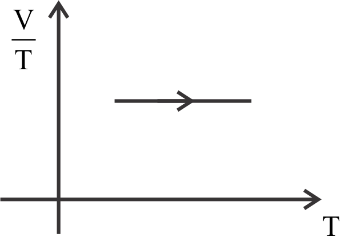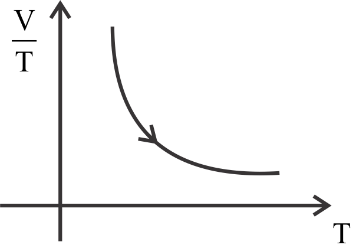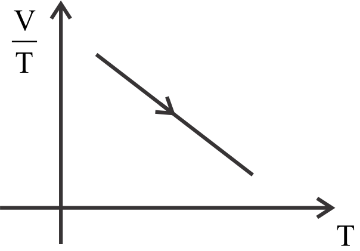
For an isobaric process on an ideal gas, which of the following graphs is correct?
(1)

(2)

(3)

(4)




Answer
219k+ views
Hint Four graphs in which the temperature is plotted against the ratio of volume to temperature is given. We have to find the graph which represents the isobaric process. To find the graph which represents isobaric processes we should have knowledge about the isobaric process and also about other thermodynamic processes to differentiate isobaric processes from other processes.
Complete step by step answer
There are different types of thermodynamic processes.
A process in which the temperature of the system is maintained throughout is called an isothermal process
In isobaric processes the pressure is maintained constant while in isochoric processes the volume is maintained constant.
If the system is insulated from the surroundings then no heat flows between the system and the surroundings and this process is adiabatic process
In the given problem the first process is an isochoric process because the volume is constant in the first process.
In the given graphs the temperature is plotted against the ratio of volume to temperature
It is an isobaric process, in isobaric process the volume is directly proportional to the temperature
$ \Rightarrow V \propto T$
$ \Rightarrow \dfrac{V}{T} \propto {\text{constant}}$
So the graph must be constant.
Let us analyse the given graphs,
The first is constant, the second graph is a curve, the third graph is decreasing constantly, and the fourth graph is increasing constantly.
In the isobaric process the ratio of volume to temperature is constant, it is neither increasing constantly nor decreasing constantly, and it is just constant and does not change.
So we can see clearly that graph 1 represents the isobaric process.
Hence the correct answer is option 1 (1st graph)
Note In the isobaric process the pressure is maintained constant by allowing the volume to expand or contract to neutralize the pressure change if any caused by heat transfer. If the system expands then the system does positive work, if the system contracts then it does negative work.
Complete step by step answer
There are different types of thermodynamic processes.
A process in which the temperature of the system is maintained throughout is called an isothermal process
In isobaric processes the pressure is maintained constant while in isochoric processes the volume is maintained constant.
If the system is insulated from the surroundings then no heat flows between the system and the surroundings and this process is adiabatic process
In the given problem the first process is an isochoric process because the volume is constant in the first process.
In the given graphs the temperature is plotted against the ratio of volume to temperature
It is an isobaric process, in isobaric process the volume is directly proportional to the temperature
$ \Rightarrow V \propto T$
$ \Rightarrow \dfrac{V}{T} \propto {\text{constant}}$
So the graph must be constant.
Let us analyse the given graphs,
The first is constant, the second graph is a curve, the third graph is decreasing constantly, and the fourth graph is increasing constantly.
In the isobaric process the ratio of volume to temperature is constant, it is neither increasing constantly nor decreasing constantly, and it is just constant and does not change.
So we can see clearly that graph 1 represents the isobaric process.
Hence the correct answer is option 1 (1st graph)
Note In the isobaric process the pressure is maintained constant by allowing the volume to expand or contract to neutralize the pressure change if any caused by heat transfer. If the system expands then the system does positive work, if the system contracts then it does negative work.
Recently Updated Pages
Two discs which are rotating about their respective class 11 physics JEE_Main

A ladder rests against a frictionless vertical wall class 11 physics JEE_Main

Two simple pendulums of lengths 1 m and 16 m respectively class 11 physics JEE_Main

The slopes of isothermal and adiabatic curves are related class 11 physics JEE_Main

A trolly falling freely on an inclined plane as shown class 11 physics JEE_Main

The masses M1 and M2M2 M1 are released from rest Using class 11 physics JEE_Main

Trending doubts
Understanding Uniform Acceleration in Physics

Understanding Collisions: Types and Examples for Students

Understanding Atomic Structure for Beginners

Understanding Centrifugal Force in Physics

JEE Main Marking Scheme 2026- Paper-Wise Marks Distribution and Negative Marking Details

Understanding Electromagnetic Waves and Their Importance

Other Pages
Ideal and Non-Ideal Solutions Explained for Class 12 Chemistry

Understanding Average and RMS Value in Electrical Circuits

NCERT Solutions for Class 11 Physics Chapter 6 System Of Particles And Rotational Motion 2025-26

Common Ion Effect: Concept, Applications, and Problem-Solving

What Are Elastic Collisions in One Dimension?

Understanding Excess Pressure Inside a Liquid Drop




